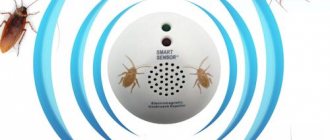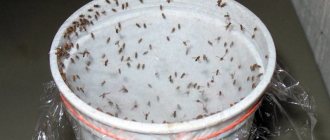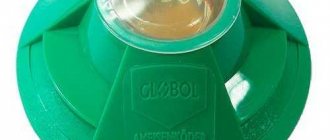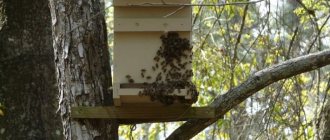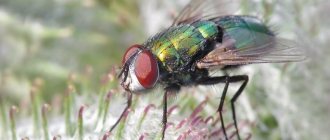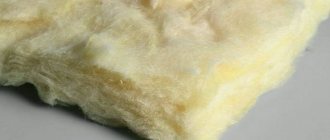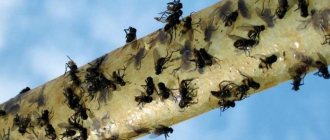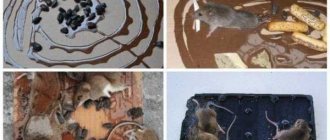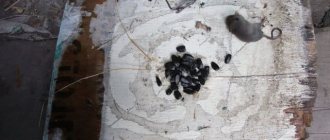Mice at home are a rather unpleasant phenomenon that is fraught with many troubles and dangers. Rodents cause great harm to households, destroying food supplies and even spoiling things. They can also become a source of various diseases.
Many people are very afraid of these animals. People have come up with many ways to combat them, from poisons to complex mousetraps. One of the “home” methods is a bottle mouse trap.
Features of operation
How to make and use a mousetrap
You can, or you can make several devices of different types with your own hands at home to catch nimble rodents.
Traps are either disposable or reusable. The owners will need items that are always at home: a bucket, a plastic bottle, a glass container, bait, plywood. Mousetraps are in no way inferior to factory products; the cost of simple traps is much lower. Adviсe:
- First you need to find the hole from which the nimble rodents come out, and determine the approximate number of mice. Sometimes there are so many pests that they calmly move around the house not only at night, but also during the day, despite the presence of residents;
- for greater efficiency, owners who have experienced the effect of trapping containers recommend installing several devices;
- one more nuance - the bait for mice should have a bright aroma. Good options: makha, fried sunflower seeds, lard, smoked sausage, cheese;
- Don’t despair if rodents bypassed one trap: you’ll have to try another option, fortunately, the cost of homemade devices is minimal.
From a can
How to proceed:
- Wash the liter container and roll it up with a metal lid;
- Carefully cut the surface with a knife from the center, like a cake, slightly bend the sharp teeth down in the central part;
- inside, put a piece of smoked sausage or lard, wheat grains, fresh bread or crispy crackers;
- attracted by the smell of the bait, the mouse will penetrate the jar, but sharp strips of tin will prevent it from getting out.
From a plastic bottle
How to make:
- Wash the container (preferably with a volume of 2 liters, no less), cut off the upper part in the narrowing area (you will get a base and a cone);
- cut off the neck from the smaller part so that a mouse can get into the hole;
- turn the cone over, insert it into the lower part, seal with tape the junction of the plastic elements;
- put bait with a pleasant smell at the bottom of the bottle;
- the gray rodent smells the alluring aroma, makes its way inside through the hole, but does not get back out.
We use a bucket
How to proceed:
- you will need any bucket and a metal rod or a round wooden stick;
- mount a rod into the upper part of the container, first place a plastic bottle or tin can on it;
- the main task is to achieve free rotation of the container if you press lightly on it;
- Place the prepared trap next to the mouse hole, place a bait with a bright smell on the top of a tin or plastic container;
- the mouse smells cheese, lard or sausage, climbs onto the bottle, the container turns over, and the rodent falls down;
- For the operation to be successful, the bottle must be placed closer to the edge of the bucket so that the rodent can easily climb onto it.
Glue traps
The method of catching rodents is quite simple, but effective. The only drawback is the unaesthetic and inhumane nature of the method.
How to proceed:
- buy special glue for rodents, a base for a trap (thick cardboard, plywood, shallow plastic tray);
- Thickly coat the surface with glue and place aromatic bait on the central part;
- On the way to the bait, the rodent will stick to the sticky surface. It will not be possible to remove the pest from the adhesive base. The owners will only have to destroy the mouse and throw away the trap.
Types and Types of Mouse Traps
Broadly speaking, mouse traps can be classified according to their capture methods.
- Mechanical traps.
- Sticky traps.
- Electronic traps.
Various poisoned baits are also used to kill small rodents. The use of such baits has some limitations:
- it is undesirable to use if there is a possibility of poisoned baits being eaten not only by mice, but also by domestic animals;
- allergic reactions may occur in people;
- if the corpse of a poisoned mouse is eaten by a pet (dog, cat), it may be poisoned;
- If a poisoned mouse dies within the house in a hard-to-reach place, for example, under the floor, the smell of decomposition will bring many unpleasant moments.
Unlike poisoned baits, traps do not have the listed negative features.
A piece of paper can help make sure that there are mice in the house. It needs to be crumpled up and placed overnight in front of the hole that could serve as the entrance to the burrow. If in the morning it turns out that the piece of paper has been discarded, it means that uninvited guests have indeed appeared in the house.
Types of bait
What food is best to use as bait at home, what do these rodents like? We are taught from childhood that mice and rats prefer cheese. In fact, most rodents are indifferent to cheese.
How to lure them into a trap?
- Salo. Choose flavorful pieces of smoked or salted lard. Old, rancid pieces will not attract mice. To make the treat more appetizing, before putting it in the mousetrap, “fry” it a little with a match.
- Vegetable oil. Any kind will do, but the best is unrefined sunflower. They need to anoint a piece of bread. If you have sesame oil in your house, that is also suitable, the smell is very attractive to rodents.
- Bread and pastries. It's good if it's bran bread with a strong smell. Choose fresh and fragrant baked goods.
- Grains. Mice and rats are not indifferent to seeds and cereals. You can pour seeds, wheat, buckwheat or rice into the trap.
- Smoked sausage. Its aroma may attract rodents, but they prefer natural products.
Small cute animals only look harmless and fragile, but in fact, the presence of mice in the house means a lot of trouble. They carry potentially dangerous diseases for humans, destroy food supplies, damage furniture and books, and are also so small that they can penetrate holes no more than six to seven millimeters wide. Catching mice usually involves setting traps in areas where animals move, but you can get rid of annoying guests without the use of special equipment.
Advantages of homemade mousetraps
In order to combat pests, a large number of different methods are offered. These include special poisonous substances with an attractive odor, electric mouse traps, and ultrasonic repellers. The cost of these funds varies and can hit your pocket. A homemade mousetrap is free, but allows you to deal with pests no less effectively.
Note! It is possible to poison mice and rats with toxic substances, but when they eat the poison, the rodents hide in cracks and holes, dying there. After the death of the pest, its body begins to decompose, and a disgusting smell of rot appears, which is not easy to eliminate.
A homemade mousetrap is a humane way to get rid of pests in your home. The animal does not need to be killed. You can simply let him go or take him to a safe distance.
How to make a mousetrap?
To make such a mousetrap, you will need a wooden block measuring 40x120x90 mm with a flat and smooth surface. It is necessary to mark the position of the centers of the trap holes. Using the first drill with a diameter of 22 mm, drill blind holes to a length of 80 mm. Stepping back 25 mm from the end, drill two holes perpendicular to the trap holes per passage using a drill with a diameter of 1.5-2 mm. They must pass by dividing the diameter of the trap hole into three equal parts. These are the holes for passing. Make a longitudinal one at a distance of 6 mm from the end and 4 mm wide by 32 mm deep. Place squares on the ends and between the holes using PVA glue. Polymer adhesives cannot be used - their smell will repel rodents.
Using spring wire with a diameter of 2 mm, wind a spring with a diameter of 30 mm into 2.5 turns, leaving one end of a straight section 50 mm long (pin), the other 80 mm long (rocker arm). At the end of the rocker bend a ring (from bottom to top) with a diameter of 6-8 mm. This is a ring for attaching a catching loop through an extension cord.
Place the spring in the center of the hole so that the ring is above the groove, and mark the location of the pin. Drill a hole with a diameter of 1.8 mm and drive the pin until the spring contacts the block.
From a wire with a diameter of 1 mm, make a catch ring with a diameter of 24 mm and attach it to the rocker ring with an extension with a ring, thus creating a movable connection. The rocker arm must be in a horizontal position when connected. After this, bend the spring so that the catch ring, under the action of the spring, extends beyond the cut.
How to charge a mousetrap.
All that remains is to give advice on charging the mousetrap and laying out the bait. It is best to use sunflower seeds lightly fried in vegetable oil or small pieces of old lard as bait. You need to use a wooden spatula, as rodents can easily pick up human odor.
To make charging the mousetrap easier, make a plug with a diameter of 20 mm. Insert it through the catch ring and the catch hole. Using a large needle with thick thread, pass it through the block, encircling the rocker arm and block through two small holes. Tie the thread at the top of the rocker arm in a knot so that it is taut. Pull out the plug. The mousetrap is ready for action.
They cause disgust or fear, in addition, they are carriers of a number of diseases, eat food and spoil surrounding objects. The device for catching rats and mice described in this article will help you solve the problem yourself. You will make a mousetrap with your own hands using available materials.
Popular articles Fried fish on a plate
In situations where it is undesirable to use poisons because children or pets live indoors, and there is no time to purchase store-bought traps, you can try making a mousetrap yourself. The process is quite simple and does not require complex equipment and skills. You will need paper, different containers (buckets, plastic bottles of different sizes) and household items that are found in almost every home (wire, small pieces of wood, a school ruler, plastic bottles).
Many traps made from improvised materials are capable of operating autonomously, without recharging, and are designed to be triggered multiple times. Such mousetraps can be left when leaving home from the dacha (the main thing is not to leave the mousetrap for a long time, in order to avoid the appearance of a foul odor). In a few days, there will be no trace of mice left and you won’t have to do or buy anything.
A little about the bait
For making a mousetrap to be productive, it is not enough to know how to make it correctly. Hunting cannot be successful without the desire of the mouse to go in the required direction, and only bait can provide this.
The opinion that mice are crazy about cheese is erroneous and relates more to stereotypes than to reality. They do eat it, and they probably like it, but there are much better types of mousetrap bait:
- Flavorful grains such as sunflower seeds;
- Fried lard or sausage (especially blood sausage);
- Dry bread soaked in vegetable oil (sesame oil will definitely not leave the mouse indifferent).
The best bait for a mousetrap - video:
DIY mousetrap made of wood
This wooden mousetrap can be made with your own hands in just 15-20 minutes, but this model is the most complex. It is possible to install several traps at once, which will be located on one block.
Dimensions will be given for one trap. If you want to increase their number, then simply lengthen the bar several times.
A block with a cross-section of 5 x 10 cm is drilled to a depth of 8 cm using a ø25 mm feather drill.
Let's call this hole a “mink”. A cut is made along the block, 3-4 mm wide.
Step 3
Three thin holes with a diameter of 2-3 mm are drilled, which should be located perpendicular to the axis of the “mink”. In this case, the first hole is located in the longitudinal cut. The second hole is made approximately in the middle of the length of the “mink”. The third hole is made outside the boundaries of the “mink”.
Step 4
A ring with an eye with a diameter of ≈ 3 cm is made from iron wire. Weave a three-turn spring from elastic steel wire. The free ends of the spring should be 8-10 cm long.
Step 5
Make a three-turn spring from elastic steel wire. The free ends of the spring should be 8-10 cm long. Opposite the eyelet, a strong thread is tied to the ring. For ease of work, thread the free end of the thread into a shoemaker's (gypsy) needle.
Step 6
The thread is sequentially threaded first into the first hole (through the cut). Then from below into the second hole and the free end is fixed with tension by the peg
Please note that the ring should sink into the cut so as not to reduce the clearance of the hole
The spring is inserted at one end into the third hole, and its other end is threaded through the ear of the ring.
Step 8
Several sunflower seeds are poured inside the “mink”. A hand-made wooden mousetrap is ready for use and is in a cocked state.
The principle of its operation is as follows. The mouse crawls into the hole, smelling the smell of seeds. But her way is blocked by a thread that holds the ring tensioned by a spring. The mouse easily chews the thread, and immediately finds itself pressed under the ring.
What is the best bait to use?
Contrary to popular belief, cheese is not very attractive to mice.
Given a choice, they will most likely choose other favorite products.
Table: TOP 10 goodies for mice
Smoked lard
A very small piece is enough, because you don’t need to feed, but to catch the rodent.
Sunflower oil
It is best to use unrefined, more aromatic.
White bread
To increase the effect, you can drop a little sunflower oil on a piece.
Roasted seeds, especially pumpkin seeds
Three or four pieces are enough to attract rodents. It's better to clean them for a stronger smell. In principle, mice love almost all types of seeds and nuts, but some of them attract rodents more, and some less. Pumpkin seeds belong to the first category.
Peanut
It is also better to use it fried.
A couple of pieces are enough.
Smoked sausage
A small piece can drive a mouse crazy and forget about caution. Better results can be achieved with a product prepared naturally, without the use of dyes, preservatives or flavor enhancers.
Cold smoked fish
Smoked fish attracts many animals like a magnet, and mice are no exception.
It must be kept in mind that the product must be fresh and natural.
Cookie
You can use flavored, for example, vanilla scented.
Salted bacon with garlic
Salty lard itself attracts mice, and the aroma of garlic enhances the effect.
Rodents are carriers of dangerous infections. In addition to being an aesthetic inconvenience, they pose a health hazard to children and pets. There is a large selection of mouse traps in stores. However, there are times when there is no time to find the necessary mousetrap or there is not enough money to purchase them. In this case, self-made devices that are not inferior in quality to store-bought designs will come to the rescue. How to make a mousetrap with your own hands? You will find the answer to the question in the article.
Harm from mice
These pests need to be controlled for several reasons. Firstly, many people are afraid of mice, especially housewives. When mice appear, they panic. In addition, there are a number of factors that are decisive. For example:
- Damage to household items. They were called rodents for good reason, since they are capable of chewing objects in the house, regardless of the material they are made of. This could be furniture, electrical wires, children's toys, shoes, etc. They especially love foam. If someone has made a renovation and used polystyrene foam as insulation, then you need to be prepared to receive such pests.
- Possibility of fire. Mice can easily eat the insulation of electrical wires, which can ultimately lead to a short circuit and fire. They can chew the power wires of many electrical appliances, so you need to regularly inspect them to ensure the integrity of the insulation.
- Presence of pathogenic microorganisms. The saliva of rodents can contain various microorganisms that can cause typhoid, cholera, plague or ordinary poisoning. In addition, mice are carriers of fleas, which prefer to feed on human blood.
- Rodents spoil food and water. This happens because mice everywhere leave traces of their vital activity in the form of feces, which are saturated with bacteria and viruses. If an animal drinks water from a cup, it can be hazardous to health.
- Mice leave behind an unpleasant odor. This is a kind of “mouse” smell, which is distinguished by its peculiarity. It is by this that you can determine that there are mice in the house. If it gets absorbed into furniture or some things, it is quite difficult to get rid of it. Some people may experience allergy attacks, which are expressed in the form of vomiting. In any case, this leads to constant discomfort.
Therefore, we can safely say that rodents cause significant harm, depriving a person of peace and comfort.
Where is the best place to set traps?
Fighting rodents indoors using live traps also involves the correct installation of the latter. To do this, first of all, you need to understand in what places mice appear, how and when they feed and move.
As a rule, these animals do not travel long distances in search of food, and usually the animals move only ten to twenty meters from the nest.
Based on this, live traps should be placed along the expected paths of movement of pests, and where they appear most often. It should be noted that mice often move closer to walls and other objects, while being quite inquisitive creatures, they can explore any object along the path of their movement.
If you are tired of the presence of mice in your home or workshop, but you cannot get rid of them, then I advise you to try making a simple but effective trap. It works without failure, all materials are available and it is suitable for those people who treat rodents humanely, since after the mousetrap is triggered, the mouse remains unharmed.
What you need to make a mousetrap
- Plastic bottle 1.5 liters
- Long anchor bolt
- Large and small wooden block
- Auxiliary tool
Making a mousetrap
First you need to clamp a large block in a vice and drill a hole closer to the edge; it should be slightly smaller than the diameter of the bolt.
Then you need to take the bottle and find its center; to do this, place the bottle on your finger and find the center by moving it.
Now, using a drill and a screwdriver, we make two holes in the center of the bottle as in the photo below. The hole can be burned with a soldering iron or a heated bolt, which is more convenient. The hole in the bottle must match the diameter of the bolt.
And screw it together with the bottle into the previously made hole on the block. You need to tighten it until the bolt head touches the bottle. The bolt should tighten firmly and not dangle, and the bottle should tilt and rise freely.
Now we take a small block, coat one of its surfaces with hot glue and glue it as shown in the photo below. You need to glue it at a slight angle so that the neck does not go down to the end, but to the middle, thereby closing the passage, and it should rise to the top freely.
The mousetrap is ready. All that remains is to put a piece of bread in it..
Install in the right place and wait!
After the mouse gets into the bottle, it lowers the neck under its own weight, thereby closing the exit. If it crawls to the bottom of the bottle, the trap will open, but as soon as it crawls back, the force of attraction will work again and the passage will close!
Jar as a trap
Jar as a trap
A glass jar is the most accessible and easiest way to catch a mouse.
To make it you need to take:
- liter jar;
- coin;
- thick wire;
- piece of sausage.
Step-by-step algorithm:
- Measure the wire using a ruler; the length should slightly exceed the diameter of the can opening.
- Put on the sausage, fold the edges.
- Place the wire in the middle of the jar.
- Place the mousetrap with the hole down and lean one side against the wall.
- Place the end of a coin under the edge of the jar. The rodent will climb inside, try to pick the sausage, the coin will fall off, and the mouse will be covered with the jar.
How to catch a mouse
It's easier to fight a pest when you know what it is.
Table: distinctive features of mice
A medium-sized animal can easily slip into a round slot with a diameter of about a centimeter and, in an extreme situation, jump up to one meter in length.
The fight against domestic rodents includes the use of spring mousetraps, glue traps, various types of repellers, and poisoned baits. At the same time, people have to change tactics all the time, inventing new devices. Live traps are the most humane means of getting rid of rodents and are quite easy to make with your own hands from scrap materials.
Humane plastic bottle mouse trap
To make such a trap you will need a plastic bottle, rope, a heavy object and bait. The rope must be tied to the neck. The rope must be of sufficient length
We put bait in the bottle. Mice are most attracted to foods with a strong aroma, but smelly chemical additives likely won't work.
It is better to use natural products as bait
The bottle should be placed on the edge of a table or other surface. We fix the end of the rope using a heavy object. Homemade mouse live trap installed and ready to go
Live trap from a jar with a coin
Making this mousetrap requires an empty glass jar, a coin and bait. Installation takes literally a few seconds. A trap made from a jar with a coin is the simplest, but very effective way to catch small rodents
Attach the bait to the inside wall of the jar. Set up the trap as shown in the photo below. This live trap may require concentration when setting up
Catching pests with a bucket and ruler
You can catch a boring mouse using a plastic bucket. To prevent the rodent from jumping out of the container, apply a little vegetable oil to the bottom and walls.
Any sufficiently deep plastic bucket is suitable for catching mice.
Popular articles Beetle from grains and seeds
The next step is to install a ruler with bait on the edge of the table
It is important to properly balance the mechanism here.
Place the bucket exactly in the center of the bait and go about your business with peace of mind. The caught rodent will not be harmed.
Live trap using a bucket and ruler installed and configured
Mousetrap made from a can and thick paper
To make the next trap you need a glass jar, a sheet of thick paper, a rope, a knife and a piece of something tasty. Cheese, of course, will do, but mice don’t like it too much, oddly enough.
Place cheese in a container, cover with paper and twist with a rope in the same way as jars of jam are sealed.
It is advisable to tighten the neck of the container more tightly
Using a knife, cut the top of the paper into a cross. The corners should be recessed a little deeper.
Using a sharp knife, cut the paper into a cross
Place the trap in an area where pests are most active. Don't forget to check it from time to time. Live traps should be checked more often, as a caught pest can escape with some effort.
Another live trap made from a plastic bottle
Take an empty plastic bottle. Cut it lengthwise with a knife by about a third of the total length. Be careful, the plastic may slip on the surface.
When working with a knife, be careful not to cut yourself
Turn the cut part over and secure it with clothespins, paper clips or, for example, hair clips.
The process of making such a live trap will not require much time.
All that remains is to put goodies in the live trap, place it in places where mice are active and provide easy access. So that the mice can gain access to the free cheese, we will use the ruler again
Spiny mousetrap
To make a trap, you will need the bottom of a plastic bottle cut in half and a knife (or scissors). The lower half of the plastic container is a live trap blank
Next, being careful, you need to cut out pointed elements with a length approximately equal to half the diameter of the container. The step width of each element does not play a big role. All that remains is to put a fragrant piece of banana in the product to attract pests, bend the cutouts inward and wish yourself a successful hunt
The mousetrap should be installed in areas of increased rodent activity, so the chances of success increase significantly
All that remains is to put a fragrant piece of banana in the product to attract pests, bend the cutouts inward and wish yourself a successful hunt.
The mousetrap should be installed in areas of increased rodent activity, so the chances of success increase significantly
Advantages of self-made traps
Trade organizations offer many different devices designed for catching small rodents. But self-made traps are still somewhat preferable for a number of reasons:
- Since self-made traps are made from existing materials at hand, they will not require purchasing costs;
- Unlike some types of poisoned baits that cause allergies or have an unpleasant odor, using homemade traps will not require you to leave the house;
- Self-made traps do not pose a danger to small children;
- Possible repeated use without unnecessary costs;
- If it breaks, it's easy to make a new one.
Inhumane approach to rodent extermination
Poisons and chemicals intended to poison mice have a number of disadvantages:
- addiction of individuals to poison;
- refusal of bait;
- poisoning of pets.
And the most significant drawback is the death of the rodent from poisoning in a place inaccessible to humans, followed by the unpleasant smell of decomposition for a fairly long period of time.
Read a question from a reader - What should you do if a rat eats poison and dies somewhere in the house and it stinks?
A humane solution to the rodent problem
Gentle ways to get rid of creatures are ultrasonic repellers and a contactless trap-container, which, if caught, remains alive and well.
More bloodthirsty methods are glue fishing, chemical poisoning and mechanical traps.
A modern invention - an electronic mousetrap - is the most humane, so to speak, method of exterminating pests, since it leads to the instant destruction of an individual without suffering. You can also make a humane mousetrap with your own hands from available materials!
Operating principle of an electronic mousetrap
A modern electronic mousetrap is a specialized trap for small rodents that releases a strong electric current when the animal gets inside. Unlike ultrasonic repellers, traps destroy mice, which helps to completely clean the room of toothy pests.
The operating principle of an electronic mousetrap is extremely simple: a rodent, lured by the aroma of a treat, climbs inside the trap and receives an instantly fatal discharge of electric current with a power of 8000 V.
In addition, the design of the mousetrap is designed in such a way that the mouse is attracted to the rounded shape of the entrance to the trap, this reminds the animal of gnawed passages. And together with the fragrant bait, these factors do not give the rodent a chance to pass by.
What types of mousetraps are there?
For better visibility, here is a brief description of the main types of mousetraps used to control rodents:
- Mousetrap on a spring. The simplest and cheapest option. The spring is tensioned and the bait is placed nearby. The mouse, pulling the bait, activates the spring, and it slams the animal;
- Traps. The principle of operation is the same as that of a spring mousetrap, there is a slight difference in design;
- Cage mousetraps. A gentle method in which the animal remains unharmed and can be released;
- Glue. This is precisely one of the most cruel methods of extermination. The animal, stuck to the trap, dies a long and painful death from hunger and dehydration;
- Homemade devices. Our people are rich in wisdom and worldly tricks. Many craftsmen are able to invent something of their own to combat rodents, but the principles of operation of such devices are the same as those purchased;
- Electronic mousetraps. Modern traps, which are discussed in this article.
How to make an electric mousetrap with your own hands
The skills of handicraftsmen reach the point that many craftsmen make at home not only elementary spring traps, but also complicated electronic mousetraps with their own hands.
Moreover, there is a fairly common option - a harmless cage trap, which, when an animal gets into it, slams shut and notifies with a signal that there is an animal in the cage. Such traps are used not only for pest control, but also for catching small domestic animals without the purpose of extermination (for example, a hamster that has escaped from its cage). A diagram of such a device can easily be found in various sources, including on the Internet.
We also recommend that you familiarize yourself with the Security and Protective Deratization System (OPDS) - operating principle, installation, maintenance and efficiency of the system
Mousetrap or cat
Cats are often cited as the best remedy for mice. However, this is not true. Firstly, as practice shows, the smell of a cat is not a factor for mice that forces them to immediately leave the place where such a mark is present. Secondly, the cat hunts mice only when it is hungry, and, having eaten, stops hunting. There is no strict scientific data on how many mice a cat catches. The only statistically reliable can be considered the recorded count of mice caught by the Scottish cat Towser over the course of twenty-one years. Their number was 28,899 rodents, but if we consider the day, then this is only 4 mice during the cat’s waking period.
The famous Austrian ethologist Konrad Lorenz cites an interesting case in his books. The mousetrap, made from a handy object such as a bucket, caught about two dozen mice overnight. A cat was thrown among the rodents. The pet quickly strangled 4 mice, grabbed one of the victims in its teeth and jumped out of the bucket. Having eaten the prey, the cat did not return to the trap, but calmly went home.
Unlike a live mouse trap, properly made traps are more effective and permanently control rodents.
We make different options ourselves
To create traps, you can use materials that you always have in the house - paper, plastic bottles, other containers, a ruler, wire, etc. The main thing is that such homemade mousetraps are reusable, and some options are self-charging. You don’t have to constantly monitor them and you can catch several rodents with one device.
Sunflower seeds, toasted sunflower oil or a piece of bread dipped in it will be more effective.
However, it is not enough to know how to make a mousetrap at home, you also need to make pests interested in it, you need to be aware of what to put inside. To do this you need an attractive bait.
Everyone knows that mice love cheese, but this is more of a stereotype. No less effective are:
- Sunflower seeds
- Slices of bread fried in sunflower oil
- Small pieces of lard.
A simple version of a bucket and ruler
This is not only a simple solution to the problem, but also quite easy to implement. In addition, such a DIY mousetrap has a great advantage - all its elements are interchangeable. The bucket can be replaced with an old saucepan or other container, and instead of a ruler, use thick cardboard or a thin strip.
The design of such a mousetrap is simple; to create it you will also need a knitting needle or a metal round and rigid wire. The knitting needle rests its ends on the edge of the bucket. A ruler attached to it rests on the edge with one end, and the other should hang over the container. The bait is placed on it, closer to the end.
Such homemade traps for mice and rats will be effective provided that rodents have free access to the ruler located on top of the bucket. It is advisable to fill the container one third with water. The mouse, passing along the rail, crossing the place where it intersects with the knitting needle, shifts the center of gravity of the structure you created.
The free end of the ruler drops sharply down and the animal falls into a homemade mousetrap. If the bait is securely fastened and does not fall off when tipped over, then this design can work many times.
From a jar with cut paper on the neck
This model is similar to the previous one. Only the bait should be placed in a mousetrap, and a path should be made for rodents to the neck of the jar. The top is covered with paper cut crosswise with a razor. Stepping on the paper petals, the animal falls inside the trap.
Popular articles Making a beer keg
Such a mousetrap from a jar is not always effective, since animals are sometimes afraid of thin paper vibrating under their paws. In this design, the bait can be placed not inside the container, but suspended on a rope above it.
We make it from a glass jar and a coin
Such homemade mousetraps can also be made from a small saucepan, and instead of a coin, a large button will do. It will serve as support for the raised edge of the container. A rope or strong thread is glued to it, with a hook attached to the end. A wooden or metal rod is placed inside the jar. A cord with a hook is thrown through it, onto which the bait is placed.
In a simple version, the bait can be glued to the wall of the jar.
When the mouse pulls the food, the thread stretches and pulls the support out from under the can. The trap slams shut, and the caught rodent is trapped. The disadvantage of the trap is that it requires reloading.
Plastic bottle traps
There are many options for making models of this type. Making a mousetrap with your own hands from an ordinary plastic bottle is very simple:
The container is cut into two uneven parts, the bottom should be in the longer one. The part with the neck without a stopper is installed in the other in an inverted position. For structural strength, the bottle mousetrap is glued together.
The bait is inside the container. It is also good to grease the neck with oil. The little animal slips into the bottle and can no longer get out.
A DIY humane mousetrap could be even simpler. The neck of a plastic bottle is cut off and bait is placed inside. The container is installed so that most of it hangs over the edge of the table or shelf.
A do-it-yourself mousetrap made from a plastic bottle is tied with string to something above the table. The animal, getting inside, shifts the center of gravity, and the trap falls, sagging above the floor. With a little ingenuity, you can come up with other models of mousetraps made from plastic bottles.
Interesting video:
How to lure a rodent
Contrary to popular belief, cheese is not an ideal bait for catching mice. Of course, animals will not refuse a piece of fresh product, but if given a choice, they will prefer seeds or smoked bacon.
Table: which products are suitable as bait
| Salo | Mice really like it. Use fresh, non-rancid product. Stale lard is unlikely to be of interest to animals. |
| Sunflower oil | For bait, an unrefined aromatic product is best suited. Drop oil on the bread crust, this will attract even more pests. |
| Bread and grains | Everyone loves fresh baked goods, and mice are no exception. Grains and bran are somewhat smaller, but are also loved by these animals. Wetting a piece of baked goods with sunflower oil will enhance the effect. |
| Fish | Rodents love fish, and most of all cold-smoked seafood. Such bait must be fresh; mice keenly sense the smell of stale fish and will not go for it. |
| Sausages | This option only works if the product is made from natural ingredients. The presence of flavorings, flavor enhancers, preservatives and other chemicals will not entice pests. |
| Cheese | Regular cheese is not suitable for bait; use a smoked sausage product. Again, the presence of chemical components in the latter will not help in catching uninvited guests. |
To catch mice even more effectively, it is important to know what rodents do not like. Dried cheese, apples, chocolate and dry bread crusts will most likely not work.
Do not trap any products containing preservatives, flavorings or flavor enhancers.
Plastic bottle traps
Perhaps the most popular homemade traps are traps made from plastic bottles. As a rule, bottles with a capacity of one and a half to five liters are used.
The simplest trap is a bottle with bait placed at the bottom.
In practice, the homemade mousetrap shown in the photo has proven its effectiveness.
The bottle itself is fixed to the surface with a thread. Trying to reach the bait, the animal makes its way into the bottle and, under the influence of the weight of its body, it tips over - the bottle falls, but it hangs, held by the thread, and the mouse cannot get out of the trap.
It is very easy to make a trap out of a plastic bottle that can trap several mice during the night. The walls of the bottle are lubricated with any vegetable oil, bait is placed on the bottom and the bottle is placed obliquely, ensuring easy access to the neck. A mouse that sneaks into the bottle after the bait will not be able to get out, since the slippery surface with the absence of protrusions on which to cling with its claws will not allow the animal to move upward towards the exit/entrance.
To make such traps, you can use not only plastic, but also glass bottles. For example, they take a champagne bottle, pour unrefined sunflower oil into the vessel and roll the bottle on the table so that the oil is evenly distributed along the walls of the bottle. The rodent, attracted by the smell of oil, enters the bottle through the neck and cannot get out because its paws slide along the oiled glass.
An effective trap, which is based on the same principle that fishing gear such as tops are made on, can be made from a one and a half liter plastic bottle. Cut off the top third of the bottle and, turning it over, insert it into the lower part. The parts are fastened together using glue, wire or paper clips. The bait is placed inside such a trap, and the neck itself is lubricated with vegetable oil. The mouse crawls inside for food, but can’t get back out.
A mouse trap can also be made from half a plastic bottle. Having retreated a few centimeters from the bottom, the walls are cut along the line of the circle so that when the resulting sectors are bent, sharp teeth are formed, directed towards the center inward. The bait is placed at the bottom and these teeth will not allow the mouse that has penetrated behind it to get out.
The main danger lurking in mice
Mice are not just unpleasant neighbors, but also quite dangerous animals for human health. These rodents are natural carriers of microbes that cause diseases such as:
- various lichens and fungal diseases;
- salmonellosis;
- toxoplasmosis;
- leptospirosis;
- rabies;
- tularemia;
- pseudotuberculosis;
- rickettsiosis.
In addition, a mouse can become a source of infection with the rabies virus. The mouse itself does not bite a person, but it can manage to bite a cat that is hunting for it and infect it. Subsequently, the already sick cat attacks people.
The negative aspects of the neighborhood of mice are not limited to those listed, but the examples given are enough to take all measures to remove these rodents.
Effective mousetraps are often relevant not only for private houses in rural areas, but also for residents of apartment buildings in the city. With the onset of cold weather, rodents move to where it is warmer, and channels for laid communications and ventilation shafts make it possible to reach the upper floors. If food leftovers are not removed from the apartment at night, the trash can is left open, and there is general unsanitary conditions, there is a high probability of mice appearing.
Traps from large containers
A mousetrap made from a bucket of water is an outrageously simple but very effective device. With its help, it is possible to catch several representatives of the mouse family in one night. The process of making a mousetrap:
- Drill two holes in the top of the bucket.
- Take a metal rod, the length of which is no less than the diameter of the bucket.
- Place an empty bottle on the axle, having previously coated it with a mixture that is attractive to rodents, so that it can rotate.
- Fix the rod with the bottle strung in the drilled holes. The neck should be as close as possible to the edge of the bucket.
- Fill the bucket one-third full with plain water.
- Attach a kind of ramp made of a board to the trap, along which the mouse will climb to get the bait.
Having felt the aroma, the tailed animal will climb along the bridge to the bottle, which, under its weight, will immediately turn over and throw it into the water. Instead of a bucket, a deep basin or large pan can be used.
The device is designed to catch several individuals at once. The construction process consists of several stages:
- Take a wooden beam about 40 cm long. Drill 6 holes at the end with a diameter of 2-2.5 cm and a depth of at least 1-2 cm. These will be holes for potential captives.
- At a distance of 1 cm on the same side, saw the block lengthwise to the bottom of the notches.
- Drill 2 more holes perpendicular to the holes, into which the springs will then be attached.
- Build a spring mechanism from a knitting needle, and at the end make a loop of strong thin wire.
- Insert the free edge of the spring into the previously prepared hole, secure it to the block, and hide the loop in the cut.
- Pass the thread through the free holes.
- Place bait in the center.
The mouse will try to get to the treat and gnaw the thread, as a result of which the spring mechanism will work, and the rodent will end up in the hole prepared for it.
Traps with glue
To make such traps, a sheet of cardboard, or plywood, or plastic is smeared with a special glue, which includes rosin, pine resin, bitumen pitch and petroleum jelly. There are also modern synthetic adhesives. You can buy them at hardware stores, or prepare them yourself from the above ingredients. Bait is placed in the center of an area covered with glue, and the mouse rushing towards it becomes tightly glued and subsequently dies either from stress or from dehydration.
Use of snares
To make such a mousetrap you will need:
- cable tie;
- heavy load;
- fishing line;
- clip;
- bait.
The snare is installed as shown in the photo.
A loop is made on the fishing line to which the load is attached, into which the bait is inserted and secured with a paper clip. The mouse, grabbing the bait, pulls it out of the loop, the load ends up in free fall and tightens the snare from the cable tie.
Traditional methods
Folk methods involve a wide range of devices and methods for destroying or removing mouse brood. While we have already looked at homemade traps, we have not yet studied means that can drive away harmful neighbors.
A mint solution is effective in controlling rodents Source stroy-podskazka.ru
Coriander (cilantro) against mice Source autogear.ru
Yellow tansy flowers Source parazitdoma.ru
Peppermint
Peppermint is often used to control mice. This is an accessible, cheap and effective remedy. The aroma of the plant is pleasant to human charm, but intolerable to rodents. The herb can be used in one of 3 ways:
- Place grass in the corners of the room, plant a plant in the local area.
- Brew a strong decoction and spray the areas where mice were spotted.
- Soak rolled cotton balls or disks in the broth and place them in the corners of the room.
